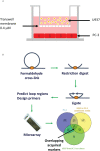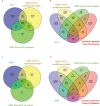Monocytes acquire prostate cancer specific chromatin conformations upon indirect co-culture with prostate cancer cells
- PMID: 36059613
- PMCID: PMC9437316
- DOI: 10.3389/fonc.2022.990842
Monocytes acquire prostate cancer specific chromatin conformations upon indirect co-culture with prostate cancer cells
Abstract
Background: Three-dimensional chromosome loop conformations are powerful regulators of gene expression. These chromosome conformations can be detected both in tumour and in circulating cells and have significant disease biomarker potential. We have recently detected specific chromosome conformations in circulating cells of patients with prostate cancer (PCa) which were similar to ones found in their primary tumours, however, the possibility of horizontal transfer of chromosome conformations was not studied previously.
Methods: Human monocytes (U937) were co-cultured in Boyden chambers through 0.4 uM membrane with or without PC-3 human PCa cells or their conditioned media and a custom DNA microarray for 900,000 chromosomal loops covering all coding loci and non-coding RNA genes was performed on each part of the co-culture system.
Results: We have detected 684 PC-3 cell-specific chromosome conformations across the whole genome that were absent in naïve monocytes but appeared in monocytes co-cultured with PC-3 cells or with PC-3-conditioned media. Comparing PC3-specific conformations to the ones we have previously detected in systemic circulation of high-risk PCa patients revealed 9 positive loops present in both settings.
Conclusions: Our results demonstrate for the first time a proof of concept for horizontal transfer of chromosome conformations without direct cell-cell contact. This carries high clinical relevance as we have previously observed chromatin conformations in circulating cells of patients with melanoma and PCa similar to ones in their primary tumours. These changes can be used as highly specific biomarkers for diagnosis and prognosis. Further studies are required to elucidate the specific mechanism of chromosome conformations transfer and its clinical significance in particular diseases.
Keywords: 3C; blood test; horizontal gene transfer; nucleome; prostate cancer.
Copyright © 2022 Alshaker, Hunter, Salter, Ramadass, Westra, Winkler, Green, Akoulitchev and Pchejetski.
Conflict of interest statement
EH, MS, AR, WW, JG and AA are employees of Oxford BioDynamics. AA and AR are company directors. Oxford BioDynamics holds patents on the EpiSwitch™ technology. The remaining authors declare that the research was conducted in the absence of any commercial or financial relationships that could be construed as a potential conflict of interest.
Figures



Similar articles
-
Chromatin conformation changes in peripheral blood can detect prostate cancer and stratify disease risk groups.J Transl Med. 2021 Jan 28;19(1):46. doi: 10.1186/s12967-021-02710-y. J Transl Med. 2021. PMID: 33509203 Free PMC article.
-
Novel insights into chromosomal conformations in cancer.Mol Cancer. 2017 Nov 17;16(1):173. doi: 10.1186/s12943-017-0741-5. Mol Cancer. 2017. PMID: 29149895 Free PMC article. Review.
-
More advantages in detecting bone and soft tissue metastases from prostate cancer using 18F-PSMA PET/CT.Hell J Nucl Med. 2019 Jan-Apr;22(1):6-9. doi: 10.1967/s002449910952. Epub 2019 Mar 7. Hell J Nucl Med. 2019. PMID: 30843003
-
Acetyl-L-Carnitine downregulates invasion (CXCR4/CXCL12, MMP-9) and angiogenesis (VEGF, CXCL8) pathways in prostate cancer cells: rationale for prevention and interception strategies.J Exp Clin Cancer Res. 2019 Nov 12;38(1):464. doi: 10.1186/s13046-019-1461-z. J Exp Clin Cancer Res. 2019. PMID: 31718684 Free PMC article.
-
Long Non-coding RNAs in Prostate Cancer with Emphasis on Second Chromosome Locus Associated with Prostate-1 Expression.Front Oncol. 2017 Dec 12;7:305. doi: 10.3389/fonc.2017.00305. eCollection 2017. Front Oncol. 2017. PMID: 29312884 Free PMC article. Review.
Cited by
-
A New Blood-Based Epigenetic Diagnostic Biomarker Test (EpiSwitch®® NST) with High Sensitivity and Positive Predictive Value for Colorectal Cancer and Precancerous Polyps.Cancers (Basel). 2025 Feb 4;17(3):521. doi: 10.3390/cancers17030521. Cancers (Basel). 2025. PMID: 39941889 Free PMC article.
-
Paradigm Lost.Cancers (Basel). 2025 Jun 28;17(13):2187. doi: 10.3390/cancers17132187. Cancers (Basel). 2025. PMID: 40647485 Free PMC article.
-
Development and Validation of Blood-Based Predictive Biomarkers for Response to PD-1/PD-L1 Checkpoint Inhibitors: Evidence of a Universal Systemic Core of 3D Immunogenetic Profiling across Multiple Oncological Indications.Cancers (Basel). 2023 May 10;15(10):2696. doi: 10.3390/cancers15102696. Cancers (Basel). 2023. PMID: 37345033 Free PMC article.
-
Circulating Chromosome Conformation Signatures Significantly Enhance PSA Positive Predicting Value and Overall Accuracy for Prostate Cancer Detection.Cancers (Basel). 2023 Jan 29;15(3):821. doi: 10.3390/cancers15030821. Cancers (Basel). 2023. PMID: 36765779 Free PMC article.
References
-
- Iljin K, Wolf M, Edgren H, Gupta S, Kilpinen S, Skotheim RI, et al. . TMPRSS2 fusions with oncogenic ETS factors in prostate cancer involve unbalanced genomic rearrangements and are associated with HDAC1 and epigenetic reprogramming. Cancer Res (2006) 66(21):10242–6. doi: 10.1158/0008-5472.CAN-06-1986 - DOI - PubMed
LinkOut - more resources
Full Text Sources

